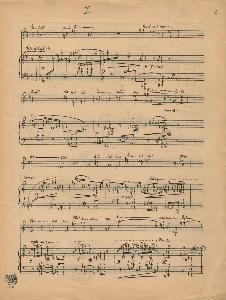Hanns Eisler (Text: Klabund)
Hanns Eisler (Text: Klabund);Hanns Eisler
Place: Leipzig
Born: 1898
Death: 1962
Biography:
**
Early Life and Musical Beginnings
** Hanns Eisler, a German-Austrian composer, was born on July 6, 1898, in Leipzig, Saxony. His family, of Jewish and Lutheran descent, moved to Vienna in 1901. Eisler's interest in music was not supported by his family due to financial constraints, leading him to self-educate in music. **
Musical Education and Influences
** At the age of 14, Eisler joined a socialist youth group, reflecting his early inclination towards political ideologies. He studied under Arnold Schoenberg from 1919 to 1923, becoming the first of Schoenberg's disciples to compose in the twelve-tone or serial technique. **
Collaborations and Notable Works
-
Bertolt Brecht**: Eisler collaborated with Brecht on several projects, including The Decision (Die Maßnahme) (1930), The Mother (1932), and Schweik in the Second World War (1957). Their collaboration resulted in protest songs that became popular militant anthems. - **Solidarity Song: A notable example of their collaborative work, this song was sung in street protests and public meetings throughout Europe. -
Ballad of Paragraph 218: The world's first song protesting laws against abortion.
Exile and Later Life
After 1933, Eisler's music and Brecht's poetry were banned by the Nazi Party. Both artists went into exile. Eisler composed the national anthem of East Germany and scores for films, reflecting his adaptability in a changing political landscape.
- Notable Links from Wikioo.org: **
- Explore more on Hanns Eisler's collaborations with Bertolt Brecht through [Wikioo.org's Collection](https://Wikioo.org/Art.nsf/O/A@D3C7GZ) featuring works influenced by their partnership.
- Discover the impact of German Expressionism in [The Museum Collection Hugo Fischer (Bühl, Germany)](https://Wikioo.org/Art.nsf/O/A@D3BSD9), reflecting the era's artistic and political upheaval. **
Legacy
** Eisler died on September 6, 1962, in East Berlin, leaving behind a legacy of music that not only reflected his political beliefs but also influenced generations to come. The Hochschule für Musik Hanns Eisler Berlin is named after him, a testament to his enduring impact on the world of music and art. **- Relevant Wikipedia Links: **
- [Hanns Eisler](https://en.wikipedia.org/wiki/Hanns_Eisler) - For an in-depth look at Eisler's life, collaborations, and musical influences.
- [The Munch Museum (Oslo, Norway)](https://Wikioo.org/@@/A@D3CCL7) - Though not directly related to Eisler, this museum showcases the evolution of art, reflecting the broader context of artistic innovation during Eisler's time.

